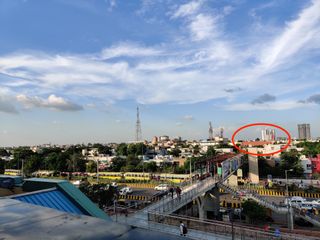Why you can trust TechRadar
Specs and performance
- Qualcomm Snapdragon 855+ gives a minor boost to performance
- 8GB RAM and two storage variants- 128GB/256GB
The OnePlus 7T features the latest Qualcomm Snapdragon 855 Plus chipset, which is a minor upgrade over the Snapdragon 855 that powers the OnePlus 7 and 7 Pro. On paper, the 7T returns 10-15% faster benchmark scores, and 15% faster graphics rendering than the OnePlus 7.
You get 8GB of RAM in both the 128GB and 256GB models. We've only tested the 8GB/256GB variant, but we wouldn't expect a noticeable difference performance-wise in the 128GB phone.
Like other OnePlus 7-series phones, the 7T handles everything you throw at it with ease, and we haven't experienced any performance issues with the phone until now.
There aren’t many games optimized for 90Hz available at the moment, so we ran the graphically demanding PUBG Mobile (optimized for up to 60fps) for an extended period each day, and we can safely say smartphone gamers won't regret buying this phone. The Snapdragon 855’s Adreno 640 element on board the OnePlus 7T can handle any graphically intensive game you’ll find on the Play Store right now.
Needless to say, if a phone can handle gaming this well you won’t have any issues with less-demanding tasks such as web-browsing, and as mentioned we didn't notice any performance glitches in day to day use – if you want a phone that delivers reliable performance, the OnePlus 7T is going to be a safe choice.

Battery life and charging
- Faster Warp Charge 30T gets you from 0-100% in around an hour
- All-day battery life from a full charge with average use
We were impressed with the battery life on the OnePlus 7, and the OnePlus 7T has a 3800mAh cell that’s slightly bigger than the one in that phone, and although the 7T has a more power-hungry display, the impact on battery life is minimal.
Starting from a full charge, the 7T easily lasted us from 9 am to 5 pm with moderate use, with more than 40% battery remaining when we clocked off from the office. We spent one day testing the battery in more extreme conditions, with heavy camera usage and intense gaming sessions, and it lasted us more than six hours on a full charge which is about the standard.
We also ran a battery test, streaming a 45 minutes video on Netflix at maximum volume and brightness using cellular 4G, and found the phone lost 9% of its charge; twenty minutes of web-browsing, meanwhile, consumed 7%.
The OnePlus 7T comes with improved fast-charging tech, which the company calls Warp Charge 30T. OnePlus says it's 18% faster than the previous version of its charging tech and claims it’ll get you from empty to 50% in 20 minutes, and to 100% in an hour.
In our charging test, it took 56 minutes to charge the 7T from 7% to 100%. Additionally, the company has improved its tech to ensure that the phone charges at a constant speed, and to avoid it heating up, even when you're playing intensive games while it's plugged into a socket. We didn’t get a chance to test that particular claim, but we'll be sure to do so during our full review process.

Camera
The OnePlus 7T’s rear camera array comprises a 48MP wide-angle camera with f/1.6 aperture, a 16MP ultra-wide camera, and a 12MP telephoto lens. The addition of the telephoto lens is the only change here over the OnePlus 7 Pro. The 16MP selfie camera is inside the waterdrop notch, just like the OneOlus 7.
While the camera on the 7 Pro wasn't that amazing given its price, the 7T convincingly justifies its price tag. The camera feels like a significant improvement, with some impressive software wizardry on tap to optimize your images.

Shot using macro mode

Shot using macro mode

Shot using macro mode

The camera now includes a macro mode and an ultra-wide night mode that brings the existing nighttime features to the wider camera. Macro mode allowed us to get closer to the subject and it impressed us in a go. It won't be the primary mode for shooting, but it's a great option to get creative with the lenses.

Nightscape mode

Nightscape mode

Nightscape mode

Nightscape mode
The night mode shows considerable improvement, especially in terms of sharpness and details. We could see better details on subjects like buildings, trees or even people. Also, the company seems to have got rid of the blown-out sky in night mode as it did on the 7 Pro, which is great. We still can't call it as good as the Pixel 3A's night mode, but it's get's close in some cases.











In good light, the images exhibit great colors and ample details. All the cameras shine in daylight, especially on a sunny day when there is a clear blue sky.


It also shows surprisingly good results using the 10x zoom. The first picture shows the building that we shot using the 10x zoom from the same point.



Wide-angle portrait

Normal portrait
Portrait shots also look good. The depth effect looks natural, and taking portraits of moving subjects seemed to be slightly easier. We tested the portrait mode on a playful street dog and got some impressive results. However, it still struggles with handling exposure at times. Note that the portrait mode now also work on the wide-angle lens.

Selfie in natural light look good.

Front camera in low light aren't very convincing.

Selfies in artificial light look decent too.
The front camera clicks decent selfies in good light, but it still fails to get a clear low light selfie without flash.
In terms of performance, the camera is pretty fast to focus and shoot across all three lenses. Processing time is reduced, scene judgment is better and colors now look balanced -- all this shows that OnePlus has worked hard on the software side of the camera.

16MP telephoto lens (2X optical zoom)

48MP primary camera

12MP ultra-wide lens
Like most recent smartphones, the 7T also has a very versatile set of cameras to give enthusiasts more options to experiment. What's better? All the modes are now more consistent and reliable.
Current page: Performance, battery life and camera
Prev Page Introduction, design and display Next Page Software and verdictSudhanshu Singh have been working in tech journalism as a reporter, writer, editor, and reviewer for over 5 years. He has reviewed hundreds of products ranging across categories and have also written opinions, guides, feature articles, news, and analysis. Ditching the norm of armchair journalism in tech media, Sudhanshu dug deep into how emerging products and services affect actual users, and what marks they leave on our cultural landscape.
His areas of expertise along with writing and editing include content strategy, daily operations, product and team management.

